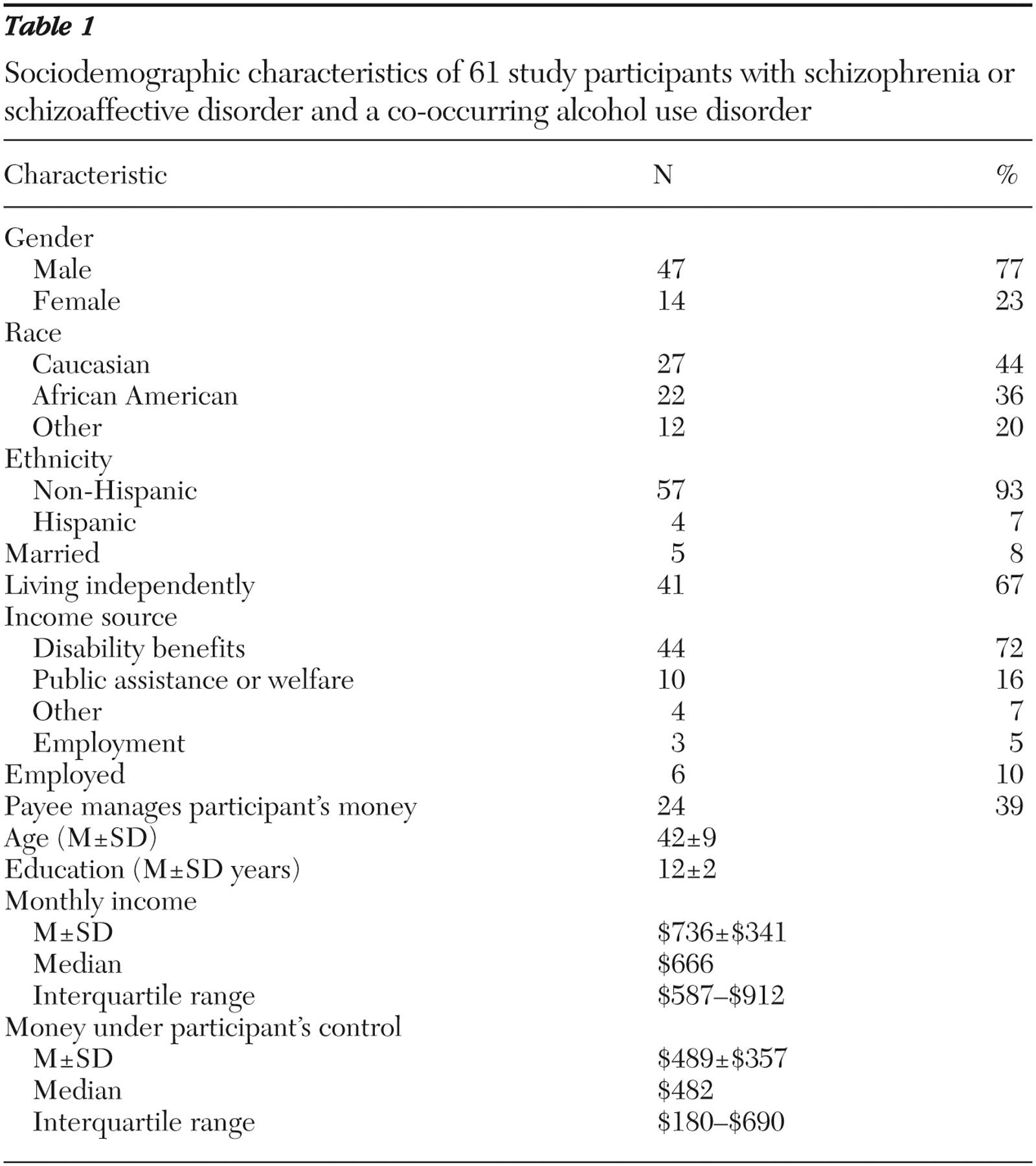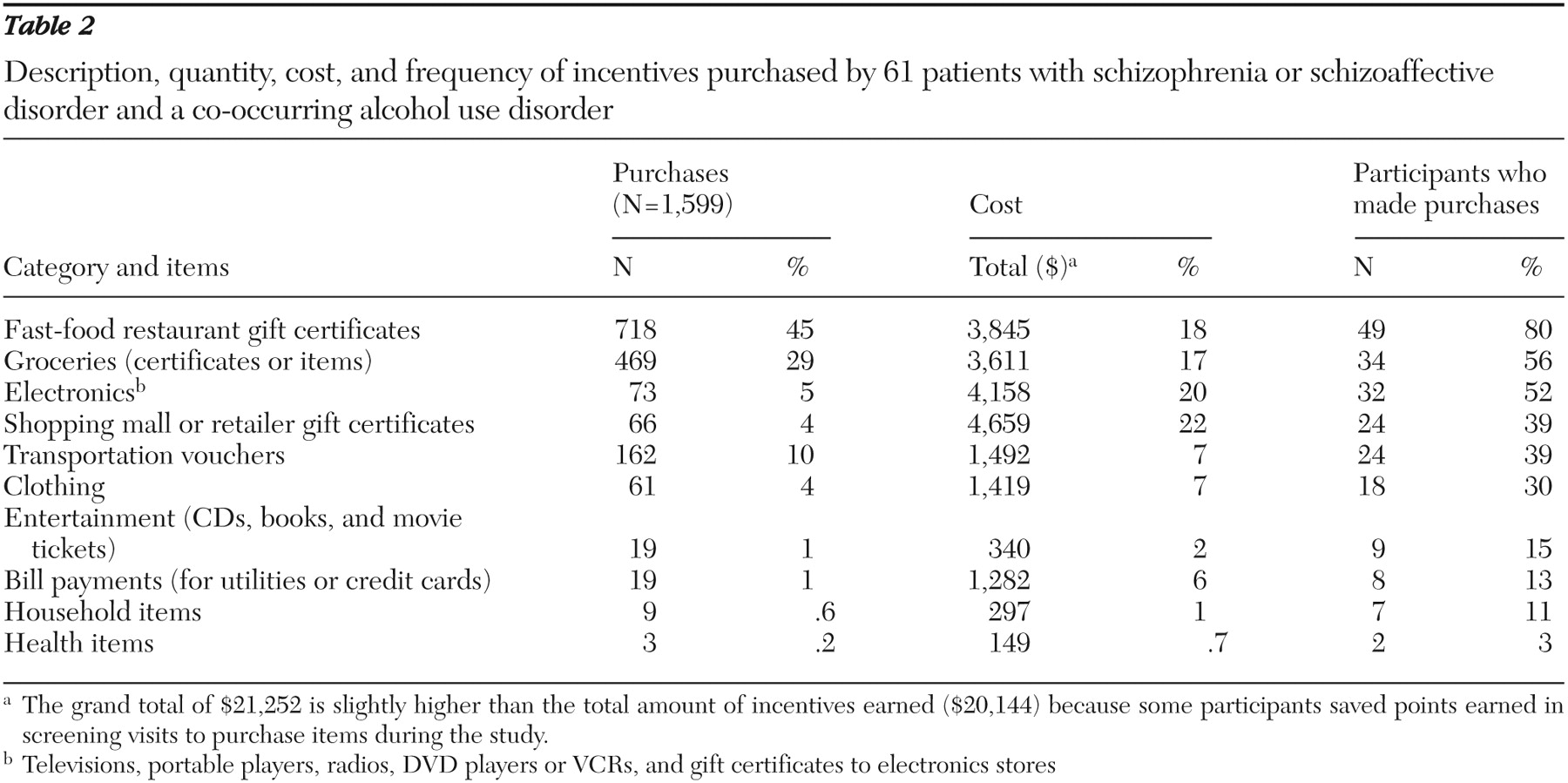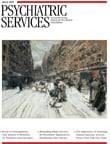Comorbid alcohol use disorders are known to have significant adverse effects on the course of schizophrenia and are associated with worsening of psychiatric symptoms and increased risk of rehospitalization (
1 ). Naltrexone is an effective pharmacotherapy for alcohol dependence, and several studies have found that it can reduce alcohol use by patients with schizophrenia (
2,
3 ). Adherence is essential to naltrexone's effectiveness; recent studies have shown significant differences in outcomes between naltrexone and placebo among only patients who demonstrated adherence to more than 80% of possible naltrexone doses (
4 ).
Poor adherence to medication is well documented for patients with schizophrenia, and among the patients with this disorder, substance abuse and dependence are strongly associated with nonadherence (
5 ). Patients with serious mental illness also have poor treatment attendance and high dropout rates in clinical research trials. Recent meta-analyses have shown pooled dropout rates that ranged from 28% to 55% (
6 ). Patients with schizophrenia also have poor attendance at outpatient visits, particularly if they have co-occurring substance use disorders (
7 ).
Adherence to naltrexone or other medications could be improved by ensuring attendance at scheduled visits. Attendance is particularly crucial for directly observed treatment interventions, because patients must be present in order to receive medication. In clinical trials, attendance is essential for pharmacotherapy, psychotherapy, and administration of research measures. The use of incentives is one possible method to increase attendance and thereby facilitate treatment adherence. This approach has its roots in the token-economy social learning studies of the past several decades (
8 ). More recently, voucher-based incentives have been shown to be effective in the treatment of substance use disorders (
9 ). Silverman and colleagues (
10 ) have shown that abstinence is increased by an incentive system with escalating rates of reimbursement based on consecutive drug-free urine tests.
Only a few studies have extended the use of incentives in substance abuse treatment to patients with comorbid severe mental illness (
3,
11,
12,
13 ). For example, Petrakis and colleagues (
3 ) studied a sample of 31 patients with schizophrenia or schizoaffective disorder and provided incentives in the form of cash reimbursement at a fixed rate of $10 per each weekly research visit. They achieved 81% retention in a 12-week trial of naltrexone. Strong Kinnaman and colleagues (
13 ) used contingent, escalating, low-cost, voucher-based incentives to reinforce drug-negative urine tests as a part of the behavioral treatment of substance use among 59 patients with comorbid serious mental illness, of whom 34% had schizophrenia or schizoaffective disorder. Although they found that severity of psychiatric symptoms did not appear to impair the ability of participants to utilize incentives, a diagnosis of schizophrenia was associated with lower incentive earnings.
To our knowledge, there are no reports of studies using contingent voucher-based incentives to increase treatment attendance of patients with schizophrenia and substance use disorders. Given that incentive programs may be useful in research or clinical treatment settings that require frequent visits, we report the application of a voucher-based incentive system for ensuring attendance by patients with alcohol use disorders and schizophrenia. We assessed the effect of psychosis severity and other variables on utilization of incentives.
Methods
This study analyzed data from the first 61 participants who entered a controlled clinical trial funded by the National Institute on Alcohol Abuse and Alcoholism, which involved directly observed treatment with oral naltrexone or placebo for alcohol use disorders co-occurring with schizophrenia (
14 ). The target number for the parent trial is an eventual 90 participants; the study is projected to be completed by June 2008. The goal of the parent study is to assess the effectiveness of directly observed naltrexone treatment. The incentive system was used to recruit and retain participants. All participants received incentives for attendance, and there was no control group because the parent study was not designed to evaluate the efficacy of incentives.
This report provides a description of the voucher-based incentive system and its feasibility for use with patients with schizophrenia or schizoaffective disorder and an alcohol use disorder. Participants were recruited from community mental health clinics in Syracuse, New York, and provided written informed consent approved by the State University of New York Upstate Medical University Institutional Review Board. Data were collected from November 2003 to August 2006. All participants were confirmed to be in routine outpatient clinical treatment; all were confirmed to be prescribed antipsychotic medications by their clinical treatment providers. The baseline demographic characteristics of participants are outlined in
Table 1 . [A table listing participants' baseline clinical characteristics is provided in an online supplement to this brief report at ps.psychiatryonline.org.] Overall, the sample was primarily male, single, Caucasian, and unemployed, and they earned a low income (most patients received disability payments).
Participants were asked to attend three visits per week for directly observed treatment with oral naltrexone or placebo over 12 weeks. All received weekly motivational counseling sessions and were seen in research offices located at their respective outpatient clinical sites. If needed, participants were provided assistance with transportation (with bus tokens, bus passes, or taxi service).
A monetary-value, voucher-based incentive system was implemented to maximize attendance and to reimburse participants for their time. Vouchers were dispensed on completion of each study visit and could be exchanged for goods or services at any time. At each visit, participants could choose to either use ("spend") the vouchers, by asking to exchange them for items, or save them for future use. The voucher-based incentive system was modeled on the work of Silverman and colleagues (
10 ), wherein cash-value vouchers increased in value with each visit attended and were reset to a lower value after a missed visit.
In this study, vouchers began at $5 per visit and increased in increments of $1 for each consecutively attended visit until a maximum of $10 per visit was reached. This maximum level was maintained unless the participant missed an appointment. In the event of an unexcused missed visit, the voucher value for the next visit was reset to $5. Participants could earn a maximum of $425 in vouchers during the 12-week treatment phase. As in the Silverman team's design, this schedule was meant not only to increase the absolute number of attended visits but also to reinforce the consistency of attendance. On the basis of our prior work (
2 ), a wide range of items—such as gift certificates to grocery stores and restaurants, bus tokens, and portable CD players—were offered in an effort to provide specific rewards that had high salience to participants. [An appendix describing the voucher-based incentive system in more detail is provided in an online supplement to this brief report at ps.psychiatryonline.org.]
The following measures were administered at baseline: Positive and Negative Syndrome Scale (PANSS), Calgary Depression Scale for Schizophrenia (CDSS), Addiction Severity Index (ASI), and Time Line Follow Back (TLFB). At the end of treatment, participants completed an end-of-study form that included a question about the helpfulness of the voucher incentive system (the 5-point Likert scale of responses ranged from not helpful at all to very helpful).
On the basis of their attendance at the three-times-per-week study visits, participants were classified as either consistent attendees, who attended 80% or more of visits, or inconsistent attendees, who attended less than 80%. This dichotomy was based on previous studies of naltrexone treatment in which adherence to naltrexone was defined by whether 80% of doses were taken (
4 ). To calculate attendance percentage, the total number of completed study visits was divided by the total number of possible visits minus the number of visits missed as a result of circumstances beyond the participant's control (because of hospitalization, for example). Voucher spending was assessed by the percentage of visits at which participants spent some or all portions of their earned incentives. Sociodemographic data, psychiatric status (measured by the PANSS and CDSS), and alcohol severity (measured by the ASI and TLFB) were also measured at baseline.
We used Spearman's rho correlations to assess the relationships between spending rates and other continuous variables (PANNS, CDSS, and TLFB results). We compared spending rates by using categorical variables and Student's t test or one-way analysis of variance. We compared continuous outcomes by attendance categories (consistent attendance or inconsistent attendance) using Student's t test. Data were analyzed with SPSS (version 14.1) for Windows.
Results
Of a possible 38 total research visits (with visits missed for hospitalization or incarceration factored out), mean±SD attendance was 31±10 visits (82%). Of the 61 participants, 47 (77%) were consistent attendees, present at 80% or more visits, and 14 (23%) were inconsistent attendees. Consistent attendees made 96%±5% of the visits; inconsistent attendees made 49%±28% of the visits.
The total amount of incentives earned by 61 participants over the course of 12 weeks was $20,144. The amount of incentives earned by each participant was $330±$123 (78% of the maximum possible), with a median of $386 (interquartile range $274–$425, which was 91% of the maximum possible). The participants spent incentives at 42%±22% of their visits. The descriptions and frequencies of incentives purchased as well as their quantities and cost are displayed in
Table 2 . The incentives purchased most frequently were restaurant gift certificates, followed by groceries and electronics items.
Spending was inversely correlated with participants' income ( ρ =-.33, p<.02) and the amount of funds under participants' direct control ( ρ =-.36, p<.005). The participants with a payee who managed their money were expected to have less direct control over their funds and were found to spend significantly more frequently than participants without a payee (at 58% of visits versus 28%, p<.001).
Our t-test comparisons of consistent attendees with inconsistent attendees in regard to demographic characteristics (age, gender, race, ethnicity, years of education, marital and employment status, living situation, income source, monthly income and amount under control, and payee status) and clinical characteristics (measured by the PANSS, CDSS, ASI, and TLFB) revealed no significant differences between groups. Consistent attendees also were not significantly different from inconsistent attendees in spending frequencies.
Utilization of vouchers as measured by spending rates did not significantly vary by severity of psychotic symptoms or depressive symptoms. Of 53 respondents 94% perceived the incentive system as very helpful or helpful (very helpful, 37 participants, or 70%; helpful, 13 participants, or 25%). Only three participants (6%) indicated that their perception of incentives was neutral.
Discussion
Voucher-based incentives that escalate in value to ensure attendance at research visits for directly observed alcohol pharmacotherapy are feasible to use and are acceptable for patients with schizophrenia spectrum disorders. Although Medicaid and other insurance programs do not cover the cost of incentives, other potential funding sources may include community-based agencies, local businesses, or government grants.
The incentive system used in this study was established to maximize attendance and was tailored to individual study participants. More than three-quarters of participants were consistent attendees, attending more than 80% of visits. This result is particularly impressive in that the demands placed on participants were high, with a requirement to attend three times per week for 12 weeks. Although these high attendance rates were attained in the presence of incentives, we cannot draw conclusions regarding causality because there was no control group and all participants received incentives. Nearly three-fourths of participants chose to save their vouchers rather than immediately spending them at each visit. These participants chose to purchase higher-cost items rather than immediately buying a lower-priced item. Voucher utilization was not related to severity of psychotic or other symptoms, indicating that patients with schizophrenia spectrum disorders may be cognitively organized enough to plan ahead and save vouchers for larger purchases. Participants preferred food items over other incentives, which may be understandable given that most participants had low income and nearly 90% were receiving disability income or public assistance. It may be useful for researchers and clinicians designing future incentive-based programs to tailor potential incentives to participants' sociodemographic characteristics.
Patterns of spending appeared to have no significant relationship to demographic characteristics or severity of psychiatric symptoms, a finding that supports similar conclusions regarding the use of incentives by Strong Kinnaman and colleagues (
13 ). Our data provide evidence that such an incentive system is feasible and applicable to a diverse population with a wide range of demographic characteristics, psychopathology, and severity of alcohol use disorder symptoms.
Economic variables, such as income and the amount of funds under the participant's control, affected the rate of spending versus saving of vouchers. Participants with more money available to them under their direct control may have been able to better "afford" to save more in comparison with those with less money available for their immediate needs.
Conclusions
It is feasible to apply an escalating system of voucher-based incentives to reinforce attendance for directly observed medication of participants with schizophrenia and alcohol use disorders. Participants had high attendance rates, were able to save incentives for future larger purchases, and found the incentives helpful. The incentive system described here may be applicable to research and clinical programs, particularly those that require frequent attendance for directly observed treatment or other intensive interventions. A limitation of the incentive system reported here is that it is time-consuming and labor-intensive to implement.
Although broad application of the incentive system to clinical practice with patients with co-occurring disorders may be problematic because of cost, the methodology can be modified to fit the needs of different clinical settings. Less expensive approaches have been developed, using intermittent reinforcement, for example, by giving patients a chance to draw from a jar to win prizes that are of modest cost (
15 ). Future controlled studies are needed to measure the efficacy of voucher-based incentive systems in improving the treatment of patients with schizophrenia or schizoaffective disorder and substance use disorders.
Acknowledgments and disclosures
This work was made possible by grant R01-AA-013655 from the National Institute on Alcohol Abuse and Alcoholism. The authors greatly appreciate the assistance of Michelle Cavallerano, B.A., Sara DeRycke, B.S., and Katherine Strutynski, B.A., in implementing this research project. The authors also thank the patients and staff of Hutchings Psychiatric Center, Syracuse VA Medical Center, and St. Joseph's Mental Health for their assistance with the project.
The authors report no competing interests.



